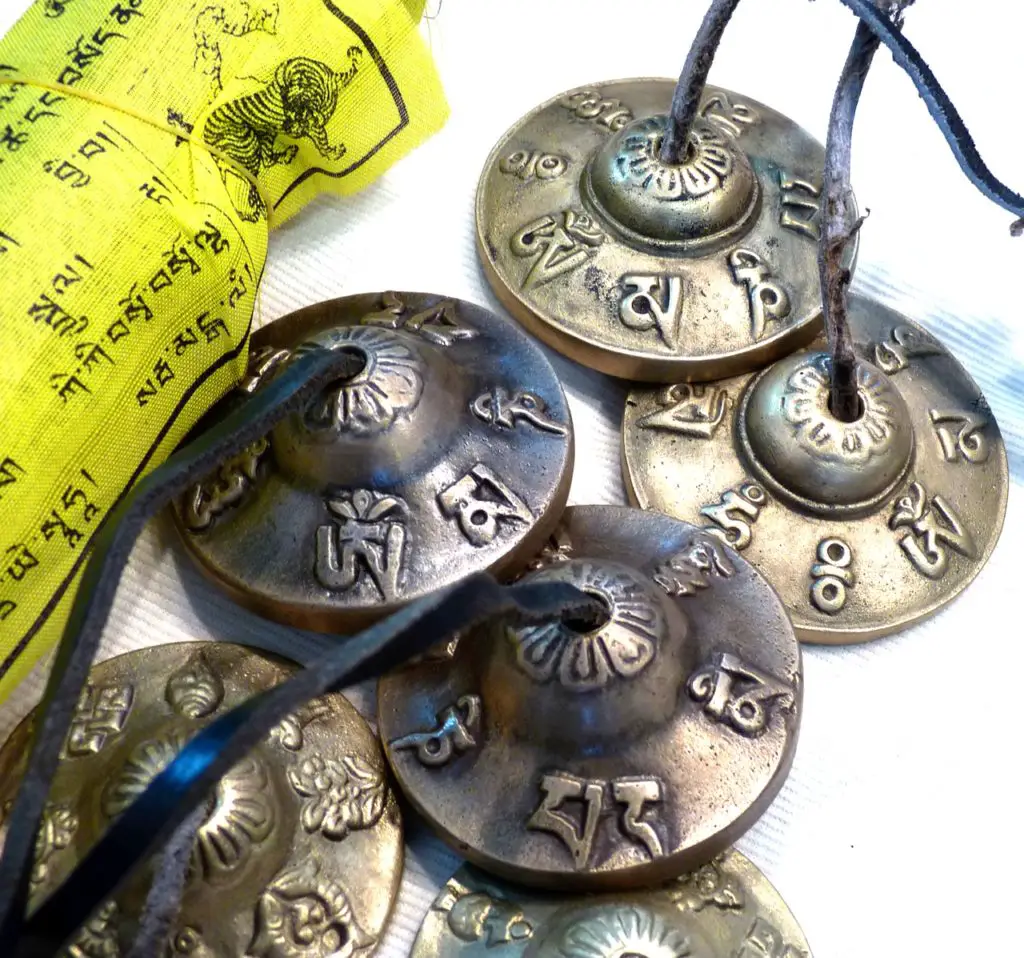For those who are not active in the Tibetan Buddhist community, nor participating in the worldwide interest in meditation and yoga, you might wonder, “What are Tingsha bells used for?”
In this article, we will explain the various uses, as well as the origins and significance, of Tingsha bells.
Often used during Tibetan prayer rituals and for their soothing, healing-promoting sounds, Tingsha bells are beloved and significant objects of religious observance, cultural identity, and contemporary wellness practices.
These sturdy bells are shaped like small, thick cymbals and are stored in a protective pouch when not in use (to protect against corrosion). Tingsha bells are designed to act in perfectly balanced sound pairs connected to each other by a short cord which is often made of leather.
So, What are Tingsha Bells Used For?

Historically, Tingsha bells signified sacred harbingers of positivity in their prime role of appeasing the “hungry ghosts” of Tibetan Buddhist religious belief. In warding off evil, reverence is given to the purity of sound emitted when one Tingsha bell is struck against the other.
In modern use, Tingsha bells are often collected as ornaments and decoration, setting the Zenlike tone of a room or displaying the significance of Buddhist art and beliefs in those practicing meditation, yoga and other healing arts. In meditation practices,
Tingsha bells are sometimes used in combination with singing bowls.

In the context of alternative healing approaches, Tingsha bells are used for wholistic cooperation of different components of the body. They move together towards peacefulness, balance, and freedom from illness.
They are also used in formal and informal ensembles and healing therapy sessions as a musical instrument.
How Do You Use Tingsha Bells?

Using Tingsha chimes is relatively simple. But having bells of superior tonal quality is the goal of avid collectors and musicians.
The ideal Tingsha tone will be identical between the two bells so that there is no discord in the two sounds when the bells strike each other.
The sound produced is clear and high, involving vibrations that are designed to relax nerves and remove blockages causing distress and potential illness in those listening. Ideally, the rung sound is of long duration and lingers to a pleasant and natural ending point.
The bells are held by the hand, using their connecting cord.
Good quality bells can ring for several minutes after a single strike.
Types of Tingsha Bells
Tingsha bells are of a familiar and standard design, although the quality of sound varies greatly. Machine-made bells are seen as inferior to older specimens which were hand-crafted with attention to the perfection of the mirrored sound between the two bells.
The bells are adorned with artistic and culturally significant motifs, in addition to silver, gold or copper coating on occasion. The bells are typically formed from a bronze alloy. Unlike contemporary Western drum kit cymbals or Middle Eastern instrumental finger cymbals, they are of a heavier, thicker design.
Most cymbals are 2 – 4” in diameter and are round. As antiquity pieces, missing cymbal mates are typically replaced with a piece of bone or wood (attached to the central cord or chain) as a substitute striker.
Why are Bells Used in Meditation?
Tingsha bells are commonly used in meditation practices as they produce a distinctive, peaceful sound that is long-ringing. The bells’ chime is seen to evoke a healthier environment and a reduction of negative energies.
Used for a positive influence on spaces and spiritual conditions, Tingsha bells bring a calm which is believed to reduce anxiety and promote feelings of rest and wellness.
There is a thread of the current health and wellness movement that asserts meditation practices, in combination with Tingsha bell use and breathing exercises, can improve respiratory health in participants.
As religiously imbued symbols of the ancient practices of Tibetan Buddhism, care should be exercised when considering the cultural appreciation and respect due to these items. Classical understanding implies the bells bestow on the listener a feeling of existential happiness and ringing the bells is often practiced as a cleansing practice for a housewarming, a new work location, or following an illness or family death.
When reflecting on the long and rich history of what Tingsha bells are used for, we can appreciate the healing, restorative, calming, and religiously significant beauty in these exquisite exhibits of Tibetan Buddhism. In our current day, Tingsha bells are a treasured addition to religious ceremonies, as well as yoga, meditation, and music therapy sessions.





